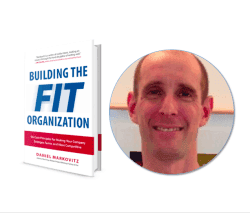
Joining me again for Episode #244 is Dan Markovitz.
Today's episode is part 2 of our discussion about his most recent book Building the Fit Organization: Six Core Principles for Making Your Company Stronger, Faster, and More Competitive, a recipient of the Shingo Research Award. You can hear Part 1 in Episode #241.
Dan was also a guest on Episodes #135 (talking about A Factory of One) and #52 (talking more generally about office Lean). He has also written a number of guest posts here. Oh, and he has his own blog.
In part two, Dan walks through the final three of his six principles: standard work, visual management, and coaching. He explains why standard work should be developed by the people who do the work, not imposed from above, and how leaders can use their own standardized routines to stay focused on the most important priorities. The discussion then turns to visual management, highlighting its role as real-time feedback that helps individuals and teams stay on pace–whether in the gym or in the office. Finally, Dan introduces the “Coaching Triangle,” emphasizing the importance of going to see, participating directly, and showing respect in ways that help people grow into better problem-solvers.
Throughout the episode, Dan and Mark connect these practices back to the broader metaphor of fitness, showing how organizations can build sustainable strength through daily habits, clear feedback, and supportive leadership. Leaders and practitioners will find practical lessons for applying Lean in ways that engage people, improve performance, and ultimately build healthier, more competitive organizations.
Streaming Player

For a link to this episode, refer people to www.leanblog.org/244.
For earlier episodes of my podcast, visit the main Podcast page, which includes information on how to subscribe via RSS, through Android apps, or via Apple Podcasts. You can also subscribe and listen via Stitcher.
We ended up doing two episodes to cover the six main themes of the book. Today, we're covering the last three:
- Standard work
- Visual management
- The coaching triangle
Thanks for listening!
Transcript
Announcer:
Welcome to the Lean Blog Podcast. Visit our website at www.leanblog.org. Now, here's your host, Mark Graban.
Mark Graban:
Hi, this is Mark Graban. Welcome to episode 244 of the podcast. It's March 9, 2016. My guest today is Dan Markovitz. This is part two of a discussion that we started back in episode 241 about his book, Building the Fit Organization: Six Core Principles for Making Your Company Stronger, Faster, and More Competitive.
In part one, back in episode 241, we talked about the first three themes of his book, which are: one, commit to improvement; two, increase value, don't cut costs; and three, think horizontally. Today we're going to talk about the last three. I hope you enjoy the discussion. To learn more about Dan and his book, go to leanblog.org/244.
Okay, so we're back here with part two, having a really good conversation with Dan Markovitz about his most recent book, Building the Fit Organization. Dan, thanks for coming back to continue our chat.
Dan Markovitz:
I couldn't be happier. I love doing this with you, Mark.
Mark Graban:
Yeah, and we had such a good conversation, it was running long, and we covered, among other topics, the first three key principles from your book. Dan, why don't we just jump into the fourth principle: standard work? How do you treat that in the book? What are the connections between the idea of fitness and Lean in organizations?
Principle 4: Embrace Standard Work
Dan Markovitz:
Well, if we think about standard work from a fitness metaphor, it really jives with what a lot of people know. If you're going to be powerlifting, you're going to want to hold the bar in a certain way and lift it in a certain way so that you don't blow out your back. If you're swimming, there's standard work. There's a certain way to hold your hands, to hold your head. Running, same thing. So I think that with fitness, we're used to standards.
I think in a corporate environment, there's also standardized work for leaders. What are you going to do each day? When are you going to do it? How are you going to do it? I was really struck by something that James Hereford, who is the COO of Stanford Medical Center, said to me. He lives by standard work, as do all of his direct reports. And he said the benefit for me for standardized work is that it keeps me from drowning in administrivia.
I love that because what he's saying is these things are really important, and in my position, there's a really high risk that I'm not going to get to do these things because of the million and one fires that are going to break out. This ensures that I don't lose sight of the important and I don't forget how to do my job properly. I think that there's standard work that's relevant at all levels and to all people.
Mark Graban:
Well, I think one thing that's interesting about James and his own standardized work is that, as a COO, he's got the autonomy to say, “I'm going to create my own standard work.” When you look at assembly line workers or employees in a hospital, standardized work has generally been dictated by management or engineers. This is the old Frederick Taylor approach. The thing I think is different about Lean is that Toyota people have always written very clearly, “Standardized work is developed by the people who do the work.” And that's a key distinction.
Dan Markovitz:
Yes. There's a photo in my book of standardized work that the customer service department at NFI Industries has put together. Their wall is filled with these document holders. The standard work is not in a three-ring binder collecting dust on a shelf; it's right on the wall. The customer service reps are the ones who make the standard work. And it's fascinating, they've used their own language. So it says things like, “Zoinks! The customer says that he can't be there to pick up the shipment,” or “Oh, darn, the shipping agent is out today.” They're having fun with it. It's their language, written by them.
And they don't laminate the standard work until everyone agrees that this is the way to do it. When they don't follow standard work, the first thing they do is they go to the person who didn't follow it and say, “Walk us through what you did. Help us understand why you didn't follow standard work because maybe we need to change it.” As opposed to, “What's the matter with you? You didn't follow standard work.” The assumption is that the standard work is wrong.
Mark Graban:
Or I would add, there's something in the system that prevented you from following the standardized work, something that prompted a workaround. And I think as you get away from the assembly line and highly repetitive work, I think that's the reality in jobs. There's a time and a place for judgment.
Dan Markovitz:
One thing people often forget about TWI is that the way TWI was taught was also standardized. It wasn't just, “This is how you're going to do the task,” but “this is how you're going to teach people to do this task.”
Mark Graban:
Yeah, the standardized work for the trainer, sort of like you were suggesting, standardized work for a leader.
Dan Markovitz:
Exactly. And now, in the hospital world, of course, you run into resistance and misunderstanding of this all the time.
Mark Graban:
Well, yeah. The New England Journal of Medicine published an opinion piece by a couple of doctors from Boston where they were decrying what the headline called “Medical Taylorism.” Ironically, the things they were complaining about are the same things that I complained about with the old General Motors culture: managers focusing on quantity before quality, not letting people stop the line, not listening to people. And if these doctors feel like that's the environment they're in, yeah, I would stand shoulder to shoulder and say what you're describing is a problem. But I would say Lean is the alternative, where they've somehow confounded that what's happening to them is Lean.
Dan Markovitz:
Standardized work is not one-size-fits-all, and there is adaptation and accommodation for individuals and for the environment that should be made. I used to be a coach of a high school cross-country team, and there are some basic standard principles that we follow. You don't start doing speed work until you've built a distance base. But a distance base for one person might be different for another. My high mileage weeks were probably 50-mile weeks. I had teammates that were doing 110-mile weeks because that's what worked for them. The basic principle of getting the base mileage in before we would start doing the sharpening work held regardless.
Principle 5: Use Visual Management
Mark Graban:
You mentioned 5S, a form of visual management.1 Let's bring it back to your book and the fifth principle. Talk about how visual management applies or what the parallels are from the worlds of fitness and work.
Dan Markovitz:
So in the fitness world, think about visual management as real-time feedback. If you go into a gym, one of the first things you see is yourself because there are mirrors everywhere. It's fundamentally there to help you self-correct in the middle of an exercise to make sure you do it right. If you think about the high-tech version of this, we've got all kinds of fitness trackers: Apple Watches, Fitbits, Jawbones. The idea here is you want to find out in the middle of the day that you're only at 2,500 steps if you're trying to walk 10,000. You don't want to find out at the end of the week that you missed your target because then it's too late.
Now, if you look in most organizations, particularly on the office side, the work is invisible. It's electrons, not protons. You see people sitting at their desks, and you have no idea if they're on pace or behind pace. So the question I always have is, how can we make office work visible so that we can see in real-time that this is quality or not, that we're ahead or behind?
I've been in a specialty law firm that does patent applications, and all of their work is visible. They can see at any given moment where a client matter is, what the status is. I have seen architecture and construction companies that run their projects with Post-it notes on whiteboards. At any given time, you can see, “Oh look, the carpenters are coming. Oh look, the guys laying the foundation are late.” When you have that kind of information, you have the opportunity to make real-time corrections. Everyone who's ever run a 5k race is running with a watch, and they say, “Oh look, here I am at the mile mark, and I'm 10 seconds ahead of pace.” Why don't we have that in the workplace?
Mark Graban:
Yeah, well, I think a lot of times people mistake the idea of visual management for monthly performance metrics. “Oh, we posted the chart on the wall, therefore it's visual management.” From a fitness standpoint, weighing yourself every single day, there's going to be some fluctuation that you shouldn't overreact to. But if you're trying to lose weight, you want to weigh yourself more than once a month. You need more ongoing, real-time feedback.
Principle 6: Coach for Improvement
Mark Graban:
You talk about trainers, and maybe we can transition into the sixth principle. When you talk about coaching, I think a good trainer is a coach. You talk about in the book “the Coaching Triangle.” What does that mean, and what's the importance of coaching in the context of Lean?
Dan Markovitz:
Well, I think there are three things that are really worth considering to become an effective coach.
- The first one is to go see. This is straight out of the Lean playbook, of course, genchi genbutsu. The theory here is that it's much easier to coach when you actually see what's happening.
- Participation. In my mind, the best coaches participate. So if you take a look at someone like Bill Belichick, he actually will run the plays; he'll participate in the practices. Art Byrne wrote something in his book, The Lean Turnaround, “You can't just send a memo.” John Toussaint has written the same thing. You've got to go to the shop floor. You've got to lead it. The ultimate extreme of this is Paul Akers over at FastCap. There's a fantastic video on his website, 2secondlean.com, where you can go see Paul scrubbing the toilet. If it's important enough for Paul to be showing us how to scrub the toilet, I guess it really is important.
- The last element of the triangle, I believe, is showing respect. And this is not just the obvious, “Don't be a jerk to people.” The other element is what Mike Rother has really done a great job of exploring in his book Toyota Kata: this notion of respecting people's ability to learn, to grow, to solve problems creatively on their own, with guidance, of course. Rather than just giving them the answer, help them think through it so they become better problem-solvers on their own.
Mark Graban:
And you call it a triangle because all three of those pieces need to be there in a mutually supportive way.
Dan Markovitz:
Yeah, exactly. You could just go see and participate, and if you're a jerk about it, people are not going to respect you. You can be very respectful of people, but if you never see their environment or participate in what they're doing, they're going to say, “Yeah, this really isn't all that important to the CEO.” I think that having all three creates strong community bonds that lead to continuously improved performance.
Mark Graban:
There's been so much talk in the past couple of years about coaching in the Lean community. What do you think are the biggest challenges people have if they want to be a coach and they're trying to get better at it?
Dan Markovitz:
Boy, I would say, honestly, this is my greatest area of weakness, Mark. It is so hard for me to shut my trap and to ask questions instead of telling people. I'm so used to being a teacher, and I'm always leaping into the breach and saying, “Well, what if you try this?” and doing everything that I say you shouldn't do. I'm not respecting people's ability to learn and grow. This is my greatest challenge.
Mark Graban:
Well, I think your answer raises that one of the challenges with coaching is that we need to sometimes just shut up, or we need to ask good questions and then shut up.
Dan Markovitz:
I think that, to me, is really the brilliant aspect of Mike Rother's book. He recognizes that it's really hard for us to not help. And so, yes, his five questions are robotic, and that's precisely the point, so that you don't have a choice. You read off the card and you ask these five questions the same way in the same sequence every single day. By creating the standardized work for coaching, he takes away the variation that comes from you thinking, “Oh, boy, Roger's really struggling here. Let me just give him the answer.” Mike slows you down, forces you to do these steps, and in so doing, he has codified the respect for people by forcing people to shut up, ask questions, and listen.
Conclusion to Part Two
Mark Graban:
Well, good thoughts, and I think we'll go ahead and wrap up here. We've gotten two really good episodes out of your book, Dan. Building the Fit Organization. How can people find you online if they want to talk with you, get some coaching, or learn more about your books and your work?
Dan Markovitz:
The website is markovitzconsulting.com, and it's spelled with a “v,” not a “w.” You could email me, dan@markovitzconsulting.com. I tweet under the handle @danmarkovitz. And obviously, if you Google Building the Fit Organization, that website is a redirect URL to my home page.
Mark Graban:
Okay, well, great. Well, Dan, hey, it's a pleasure talking to you. Congratulations again on the recognition of the Shingo Research Award for the book, and I encourage everyone to go out and check it out. Thanks for being a guest today.
Dan Markovitz:
Mark, it's been a great pleasure. Thanks for the opportunity.
Mark Graban:
Sure thing.
Please scroll down (or click) to post a comment. Connect with me on LinkedIn.
Let’s build a culture of continuous improvement and psychological safety—together. If you're a leader aiming for lasting change (not just more projects), I help organizations:
- Engage people at all levels in sustainable improvement
- Shift from fear of mistakes to learning from them
- Apply Lean thinking in practical, people-centered ways
Interested in coaching or a keynote talk? Let’s talk.
Join me for a Lean Healthcare Accelerator Trip to Japan! Learn More









